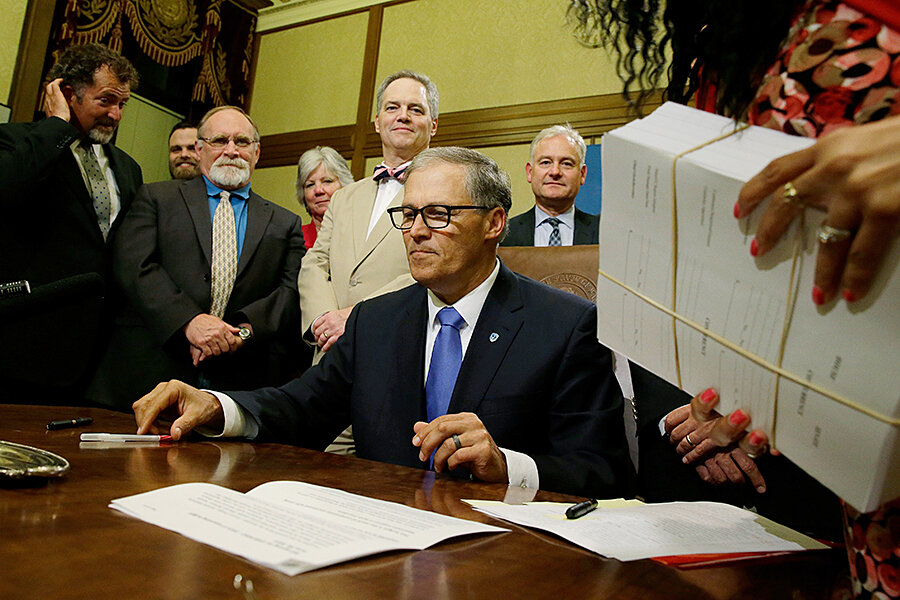Dramatic cuts to college tuition in Washington State: Will others follow?
Loading...
Washington State lawmakers reached a bipartisan agreement this week to pull skyrocketing tuition rates back to earth.
Supported by its new budget, the state over the next two years will phase in tuition rollbacks of 15 to 20 percent at four-year public institutions. Community colleges will see a 5 percent tuition cut.
Washington is the only state offering a widespread tuition break to students. But could this be the start of a trend in college affordability?
“Legislatures are under increasing pressure to hold down the sticker price of higher education, particularly by middle-class voters,” says Iris Palmer, a senior policy analyst at the New America Foundation in Washington, D.C. As state revenues grow and lawmakers “reinvest in higher education, I wouldn’t be shocked if they start to require or ask for tuition decreases.... But it’s anybody’s guess.”
Minnesota officials recently announced that tuition for two-year colleges would decrease by 1 percent for 2016-17.
Many states are still raising tuition. For those states with room in their budgets, some are opting for tuition freezes, while others are putting money back into university coffers so they can improve the quantity and quality of course offerings.
Tuition cuts aren’t always the best way to ensure value for students. “There are trade-offs to be made.... If there isn’t sufficient state funding, a tuition rollback can cut course sessions ... and students might not be able to graduate on time,” says Thomas Harnisch, director of state relations and policy analysis for the American Association of State Colleges and Universities in Washington, D.C.
Washington State may be a standout for its new policy. But the tuition cuts won’t automatically make it the most affordable place to attend college. Tuition there grew by 34 percent over the past five years. Of all the states, it had the third-highest increase from 2008 to 2015, according to a recent report by the Center on Budget and Policy Priorities in Washington, D.C.
Hailey Zurcher, who’s heading into her senior year as a medical anthropology major at the University of Washington in Seattle, is looking forward to a lighter financial burden for herself and her twin brother. “Every quarter we worry a little bit about whether or not the aid will cover our actual tuition.... That stress is going to be a little bit lifted there,” she says, noting that she already has more than $10,000 in student debt. She hasn’t calculated yet exactly how much her tuition will go down.
She knows many students who, while taking a full load of classes, work full time because they don’t qualify for financial aid. “Hopefully it will lighten their workload as they’re trying to be a student first,” Ms. Zurcher says.
Washington’s tuition rollbacks came about within the context of increased investment in education at all levels in the state. Education overall will see a 19 percent boost in the new budget, compared with a 6 percent boost for the rest of state government. The move brings education funding to a level that hasn’t been seen in 30 years, according to a recent statement by GOP state Sen. Andy Hill, the Senate’s chief budget writer and one of the bill’s sponsors.
“We are delivering historic investments and bipartisan solutions that fully fund education, make college affordable and provide needed support for our most vulnerable friends and neighbors,” Senator Hill said.
Democrats wanted to freeze tuition and invest more in financial aid, but they went along with the tuition decreases when Republicans agreed to close tax loopholes to pay for the roughly $220 million cost, The Seattle Times reports.
The bill returns tuition-setting authority to the Legislature, an arrangement that exists in some other states as well and makes moves like tuition cuts more feasible because the lawmakers have more direct control. The Washington bill also ties future tuition to the state’s average wage.
“It’s going to be interesting to ... see if this model is sustainable long term,” says Dustin Weeden, a policy specialist at the National Conference of State Legislatures in Denver. Even just freezing tuition “tends to be expensive for states,” he says. “Over time, the political will diminishes the more budget cycles you go through.”
But for now, educators and students are celebrating. “This historic tuition reduction is outstanding news for our students and their families, and I applaud the governor and legislators who came together to make this possible,” said UW Interim President Ana Mari Cauce in a statement Tuesday.








